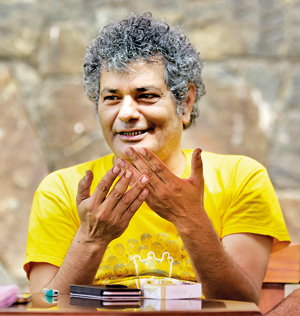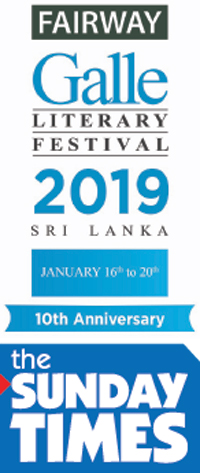“With novels, you can make your madness speak”

Mohammed Hanif: “There is a way to tell a story”. Pix by Sameera Weerasekera
In a January column for the New York Times this year, Mohammed Hanif writes about the perils of doing yoga when your mind goes into overdrive. It starts off about his propensity to make lists of random anxieties while in the savasana (corpse) pose and then seamlessly segues into the corpses he has seen in recent years. Hanif is good at this–this dark humour-dark truth transition in writing. It’s visible in his journalism and spills over into his fiction. The effect it produces on a reader is similar to that fleeting second of audience unease that hangs in the air when someone makes a problematic joke in a public setting. Do you laugh? Do you gasp? Do you walk out in anger?
Hanif’s latest novel Red Birds is replete with these moments of discomfort.The novel is told by multiple narrators and is set in an unnamed strip of land. We meet Ellie, an American pilot who has crashed into the camp he was meant to bomb.There is Momo, a precocious 15-year-old with a world weariness and war entrepreneurism which belies his age that it is easy to forget he is a boy who has lost his brother. And Mutt, a remarkably articulate, philosopher dog who often acts as a narrative placeholder to deliver a few home truths about humans.
Red Birds also takes a few swipes at the aid industry (“our camp was the tourist destination for foreign people with good intentions”) noting how “war has been condensed to carpet-bombing followed by dry rations and craft classes for the refugees.” Countries like Afghanistan and Pakistan have grown up with the aid industry and Hanif explains that he wanted to examine how the sector was intrinsically entwined with the constant business of war.
“I just wanted to explore this idea of how these things are interlinked. It’s a bit about myself as well. Because as a reporter, you go to a place where there’s a big flood or an earthquake and you spend two days and you get the juicy quotes and the moving scenes and then you write about it, and then you generally forget about it,” he explains. “I was interested in the notion of how one is complicit but how one can also convince oneself–‘I don’t have anything to do with it, I’m the good guy’.”
Mohammed Hanif, who was in Sri Lanka last weekend for the Fairway Galle Literary Festival, has emerged as one of Pakistan’s foremost literary voices in the past decade. A novelist and journalist who writes in Urdu, English and Punjabi, Hanif hailed from a farming family from Okara, in the Punjab province of Pakistan.
“I went into the Air Force when I was very young – 16 and a half. I hadn’t seen much of the world or how the world works. I came from a rural farming background. Having a career wasn’t a thing – I didn’t grow up around people who were professionals or who had jobs. You were on a farm, you grow potatoes and vegetables and that’s it. So, when I got into the Air Force, I wanted some kind of freedom from that oppressive rural life. As soon as I got into the Air Force, I realized oh shit, this is much worse. This is the opposite of freedom,” remarks Hanif wryly.
 After serving in the Air Force, his entry into journalism began when he took on assignments for a friend, who was often high on heroin, transcribing and writing out his friend’s interviews for a TV magazine. He went on to become a fashion journalist writing human interest stories and TV reviews which got him noticed. His subsequent work with Pakistani editor Razia Bhatti provided firmer footing for his writing. Bhatti, founding editor of Newsline, was noted for taking on drug cartels, corruption and political fascism in Pakistan and for wielding a sharp editorial eye in the newsroom. Armed with a draft printed off a dot-matrix printer, she would sit down with scotch tape, a red pen and a pair of scissors and begin old-school analogue editing, cutting off a sentence in one page, inserting it in another and questioning the significance of each paragraph in a 16-page article. “She made me realize there is writing and there is good writing, and there is a way to tell a story,” says Hanif.
After serving in the Air Force, his entry into journalism began when he took on assignments for a friend, who was often high on heroin, transcribing and writing out his friend’s interviews for a TV magazine. He went on to become a fashion journalist writing human interest stories and TV reviews which got him noticed. His subsequent work with Pakistani editor Razia Bhatti provided firmer footing for his writing. Bhatti, founding editor of Newsline, was noted for taking on drug cartels, corruption and political fascism in Pakistan and for wielding a sharp editorial eye in the newsroom. Armed with a draft printed off a dot-matrix printer, she would sit down with scotch tape, a red pen and a pair of scissors and begin old-school analogue editing, cutting off a sentence in one page, inserting it in another and questioning the significance of each paragraph in a 16-page article. “She made me realize there is writing and there is good writing, and there is a way to tell a story,” says Hanif.
While in journalism, there is an awareness of the limits of what you want to say and the boundaries you work with, fiction provides a foil to these constraints. “With novels, you can make your madness speak more than your common sense,” Hanif pauses. “But I’m sure they overlap.”
In one sense, fiction offers a form of world-building and escape from immediate realities. “Because as journalists, we’ve lived through some really horrible times. We’ve told depressing and horrible stories and issues. Your career will end, your life will end but there are certain kind of injustices that are there forever,” he notes.
But it’s hard to imagine Red Birds as an anodyne to the real world.The book takes a while to build up and descends into a cacophony of first-person narratives featuring more cameos in the final section. The reader is required to negotiate between this muddled Greek chorus while navigating a broken, despondent world; a halfway house between the real and supernatural. Its pithy sentences are characterized by a controlled anger at the business of war, and sadness at the business of life within war. “Real life catches up with you, even when you’re trying to run away from it,” says Hanif.
The novel was born out of a seven-year period of gestation during which Hanif went through several intimate losses of very close friends in quick succession within a year. The kind of friends one builds one’s life around. He had begun writing by then, but the book was still half-formed. He explains that in a way, the novel acted as an extension of interrupted conversations, Facebook messages, debates, fights and stories that were left mid-air after the deaths of these friends.
While the book deals with a chaotic world, the supernatural and the absurdity of war, the eponymous red birds that haunt the novel are a nod to the pain of memory when dealing with loss and grief. And it is this which lingers after you finish the book. As Mutt, the story’s animal narrator points out, “Red birds are real. The reason we don’t see them is because we don’t want to. Because if we see them, we’ll remember.”


